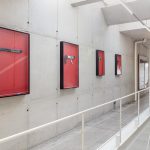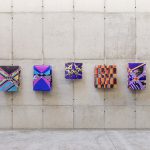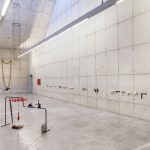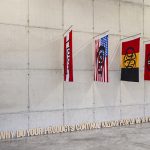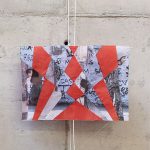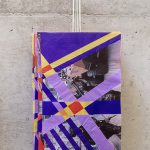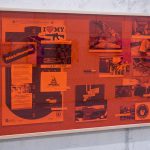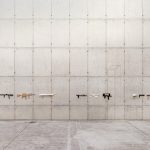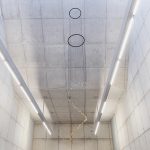Interdict
After all, the shirt served as a flag, displaying the stain of “this was”, as evidenced as an extract imprinted with the marks of the moment. The authentic representation could have been avoided. It was difficult to build an image. Nothing was guaranteed and the text was unable to deal with the irremediable. What would be made of that t-shirt? The justice did not offer any guarantee. The text had to be written in the past. And the image was built meaningfully before the wreckage. Life and art, things of the past. It is too late now… to ask for to pay attention, precaution, to come back early, to not talk to strangers, to protect yourself. It is too late now… to get into “this was”, concept of Roland Barthes for photography, and still have time to go back, to return to the scene, as in the remote device that only works for the images already recorded. The frightening traces were taken away “at the very moment when the object is thought as a dead object.” The History of Art was thought, from the death, “a work of mourning”, in the terms of Georges Didi-Huberman, but with the desire to make it sparkle.
Igor Vidor built an exhibition in the interstices of memory, between conversations, conviviality and news. He was astonished by what had been seen and narrated. He has approached fragments, capsules of revolver bullets, toy weapons made by children, logos of gun makers, quotes and speeches from official authorities (in and out of the favela). He conceived, with this, an exhibition placed in the past, after concepts like the sentence “heroes never celebrate villains; heroes only celebrate villains”. However, what was addressed did refer to a narrative of heroes and villains? Villains, somehow, have always been heroes, as the narrative’s weight, in the movies and in life, has placed them in horizontal parity: protagonist and antagonist. If the narrative took place around the hero, it was also done within the extent of the tragedy.
In Vidor’s exhibition, we reflect: what was the consequence of such visibility? We already now that violence is known as “exceeding power” when reading the newspapers in the morning, the same ones as the artist uses to produce his works. Before Marie-José Mondzain tells us that image can kill and the violence is a “potential even before turning into an act or not”, we already knew due to the contact with the reality lived, heard, seen, from the mourning of a history that prevailed before an utopic “could have been”. What was written, photographed and erased with water and broom, was also running against the grain, when the story only shows consequences. Everyday, the coexistence with the images made us to realize a force intensity that cannot be mediated. What to do about Auschwitz? Theodor Adorno’s question keeps returning. And Mondzain’s statement would now return as perplexity “where and how the violence of our images will generate the strength we need to live in society,” a sentence that should be followed by a question mark. The question becomes more complex when it reaches the logic of the desires. We know that images have become passion, shrouds, portraits.
Igor Vidor demonstrated astonishment to see children in love with weapons. Children who displayed miniature guns as string pendants. Weapons that served, thus, as amulets, as desire. Children who, nevertheless, went to school in theirs uniforms. The logic of the weapons was the same logic as of the toys. And the institutional presence of the school existed as that of the organized crime. The child kept from play’s time the desire for reconstruction. The world given only raised interest when turned inside out, involve it in another material, reconstruct it in a kite and cardboard paper. That is why weapons were amulets, between the toys and the dream, between monsters and chimeras.
The exhibition of Vidor places us, at every moment, before the conscience that it has been established a horizontality between the hero and the villain. And the hero, although warned by everyone, had to fulfil its destiny. This has always been the logic of the tragedy, difficult to change. The show has been conceived as a narrative that erased differences. Only the past of history remains. The mother was only able to keep for herself a son circumvented by affection, by singularities, as a noble meat. But, this nobility, to be enduring, will need salt and sun. It will have to occupy the roof slabs, sweat under its shirts covering its face, wear ties. And it will be, in spite of all clairvoyance of Tiresias, a blind Greek Prophet who warned Oedipus about the interdicts that is about to be committed by the hero, impossible not to fulfil the destiny. Mothers, inevitably, Pietas, Our Lady of Sorrows.
But what did the institutions do about it? It was common to hear authorities say that this problem is municipal, state, federal. And here we could question what does violence do with a commercial art gallery? However, the problem looms and becomes omnipresent. How many more it will need (…) so that, after all, images are made? The insurgency of some artworks only corroborated the fact that Art History has always dealt with the mourning. It would have been important to think about this before. Before it is necessary to place, instead of the state flag, that of the gun manufacturer at the entrance to the gallery.
Marcelo Campos
June 2018
Click here for the exhibition catalog.

